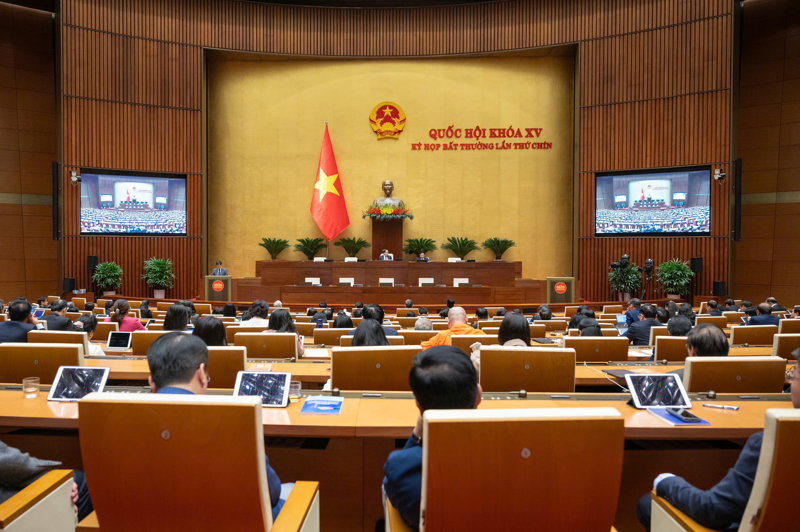The 15th National Assembly (NA) on February 19 passed a resolution on adjustment to the 2025 socio-economic development plan.
Accordingly, the GDP growth target for 2025 has been raised to at least 8 per cent, an increase of 1 to 1.5 percentage points compared to the plan approved late last year and nearly one percentage point higher than the 7.09 per cent growth rate recorded in 2024.
This adjustment is expected to provide momentum for Vietnam’s economy to reach double-digit growth in the coming years, supporting the country’s ambition to become a high-income nation by 2045.
The projected GDP size for 2025 is expected to exceed $500 billion, reflecting a $24 billion increase from the previous year. GDP per capita is anticipated to surpass $5,000, while the inflation target has been adjusted to approximately 4.5-5 per cent. If the GDP size target is achievable, Vietnam will be ranked between 31st and 33rd, in terms of economic scale, globally.
To achieve a growth rate exceeding 8 per cent, the NA has tasked the Government with continuing legal and regulatory reforms to ensure efficiency and transparency in governance, avoiding an approach of "banning what cannot be managed". Meanwhile, strategic infrastructure development remains a priority, with a focus on accelerating the completion of key projects, including Long Thanh International Airport, Lach Huyen Port, the expansion of Terminal 3 at the Tan Son Nhat International Airport (in Ho Chi Minh City) and Terminal 2 at the Noi Bai International Airport (in Hanoi) , and the commencement of construction on Lien Chieu Port in Da Nang city.
In addition, the Government is required to expedite plans for establishing international and regional financial hubs in Ho Chi Minh City and Da Nang, respectively, while also developing free trade zones and border economic areas. Special economic policies must be applied to more localities, starting with the three major cities — Ho Chi Minh City, Hanoi, and Da Nang — to unlock new resources for growth.
The resolution allows the Government to utilize approximately VND 84.3 trillion ($3.3 billion) in public investment capital from revenue surpluses and budget savings in 2024 to accelerate the construction of expressways and coastal roads. However, ministries and agencies must reduce regular expenditures by at least 10 per cent and allocate additional revenue from 2024 to invest in the Lao Cai - Hanoi - Hai Phong railway project.
If necessary, the fiscal deficit may be adjusted to 4-4.5 per cent of GDP, instead of the previously set 3.8 per cent, to secure funding for development. Public debt, government debt, and national external debt could reach or slightly exceed the warning threshold of approximately 5 per cent of GDP.
The resolution also underscores the need for a robust and transparent institutional framework to prevent bureaucratic inefficiencies and ensure accountability in public service. It calls for mechanisms that encourage innovation while protecting officials who take bold, forward-thinking initiatives.
With an economic growth target exceeding 8 per cent, the private sector is expected to contribute approximately $96 billion out of the total $174 billion in social investment capital.
To counter this, the NA has instructed the Government to introduce policies that support the private sector through preferential mechanisms, fostering large-scale, nationally significant enterprises. State-owned enterprises will be encouraged to focus on major projects that drive economic and social development while strengthening their integration with the private sector.
In addition to legal reforms aiming at enhancing financial markets, stock exchanges, science and technology sectors, and the real estate industry, the Government must also address existing bottlenecks that hinder growth in these areas. While Vietnam’s economy continues to rely on traditional growth drivers such as investment, consumption, and exports, efforts must be made to accelerate new engines of growth, including the digital economy and the green economy.
With emerging technologies such as semiconductors, artificial intelligence, and big data playing an increasingly crucial role, the NA emphasizes the need for groundbreaking policies that provide scientists with the autonomy to innovate. The Government must also establish internationally standardized training programs to develop a highly skilled workforce that meets market demands.
Additionally, the Government is required to implement policies that encourage FDI enterprises to transfer technology, increase the use of locally sourced components, and integrate more Vietnamese suppliers into global value chains. These measures aim to enhance Vietnam’s position within international supply networks and further solidify its economic standing on the global stage.









 Google translate
Google translate